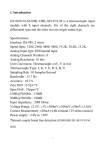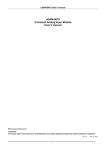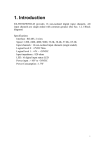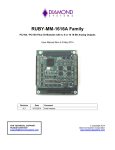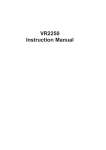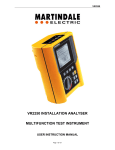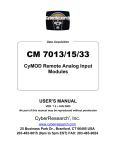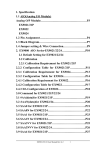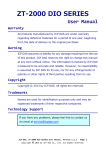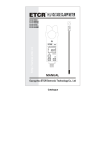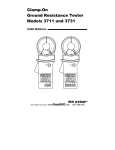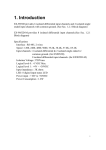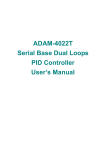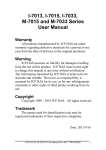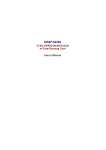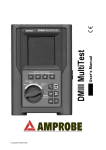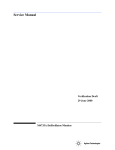Download 9017H-M manual
Transcript
1.1 Introduction EX9017H-M is a analog input module with 8 input channels. Eight channels are differential type and individual channel configuration support . Specifications: Interface: RS-485, 2 wires Speed (bps): 1200, 2400, 4800, 9600, 19.2K, 38.4K , 115.2K Analog Input type: Differential input Support individual channel configuration Analog Channels Numbers: 8 Analog Resolution: 16/12(fast mode) bits Unit Conversion: mV, V or mA Voltage range: +/-10V,+/-5V,+/-1V,+/-500mV,+/-150mV,+/-20mA Sampling Rate :10/ 50(fast mode) Samples/Second Bandwidth : 15.7 Hz Accuracy : ±0.1% Zero Drift : 0.5µV/°C Span Drift : 25ppm/°C CMR@50/60Hz : 150dB NMR@50/60Hz : 100dB Input Impedance : 20M Ohms Current Measurement: ±20mA (with external 125 ohm resistor) Power supply: +10V to +30V 1 1.2 Wire connection 2 1.2.1 Block Diagrams Vin 7+ Vin 7- EEPROM Vin 6+ 1.2.2 Wiring diagram for the EX-9017H-M Single Controller ADC Photo-Isolation Vin 6- MUX Vin 1+ Vin 1- Data+ Data+Vs GND RS485 Interface Vin 0+ +5V Vin 0- Power Supply EX9017HM 1.3 Default Settings Default settings for the EX-9017H-M modules are as follows: . Module Address: 01 . Protocol: Modbus RTU . Analog Input Type: type 08 (-10 ~ +10V) . Baud Rate: 9600 bps . Checksum disabled . Engineering unit format . Filter set at 60Hz rejection 3 1.4 INIT* Mode Operation Each EX9000 module has a build-in EEPROM to store configuration information such as address, type, baudrate and other information. Sometimes, user may forget the configuration of the module. Therefore, the EX9000 have a special mode named "INIT* mode" to help user to resolve the problem. The "INIT* mode" is setting as Address=00, Budrate=9600bps, no Checksum . Originally, the INIT* mode is accessed by connecting the INIT* terminal to the GND terminal. New EX9000 modules have the INIT* switch located on the rear side of the module to allow easier access to the INIT* mode. For these modules, INIT* mode is accessed by sliding the INIT* switch to the Init position as shown below. To enable INIT* mode, please following these steps: Step1. Power off the module Step2. Connect the INIT* pin with the GND pin. (or sliding the INIT* switch to the Init* ON position) Step3. Power on Step4. Send command $002 (cr) in 9600bps to read the Configuration stored in the module's EEPROM. There are commands that require the module to be in INIT* mode. They are: 1. %AANNTTCCFF when changing the Baud Rate and checksum settings. See Section 2.1 for details. 2. $AAPN, See Section 2.14 for details. 4 1.5 Module Status for DIO, AIO Power On Reset or Module Watchdog Reset will let all output goto Power On Value. And the module may accept the host's command to change the output value. Host Watchdog Timeout will let all output goto Safe Value. The module's status(read by command~AA0) will be 04, and the output command will be ignored. 1.6 Dual Watchdog Operation for DIO, AIO Dual Watchdog=Module Watchdog + Host Watchdog The Module Watchdog is a hardware reset circuit to monitor the module's operating status. While working in harsh or noisy environment, the module may be down by the external signal. The circuit may let the module to work continues and never halt. The Host Watchdog is a software function to monitor the host's operating status. Its purpose is to prevent the network from communication problem or host halt. When the timeout interval expired, the module will turn all outputs to predefined Safe Value. This can prevent the controlled target from unexpected situation. The EX9000 module with Dual Watchdog may let the control system more reliable and stable. 1.7 Reset Status The Reset Status is set while the module power on or reset by module watchdog and is cleared while the command read Reset Status ($AA5) applied. This is useful for user to check the module's working status. When the Reset Status is set means the module is reset and the output may be changed to the PowerOn Value. When the Reset Status is clear means the module is not rested and the output is not changed. 5 1.8 Calibration(Warning: Please don't calibrate before you really understand.) Set the module of data format to which you wish to calibration first. Protocol: ASCII mode. Address: 01 Input type: which type you wish to calibration Filter: which rejection you wish to calibration Perform Zero Calibration: 1. Send the command “$01501” to CH0 enable, CH1~7 disable. 2. Apply zero voltage/current to module’s channel 0 (Vin0+ to Vin0-) 3. Send the command “~01E1” to enable calibration. 4. Send the command “$011” to perform zero calibration. Perform Span Calibration: 1. Send the command “$01502” to CH1 enable, CH0 & 2~7 disable. 2. Apply Span voltage/current to module’s channel 1 Type code Span 08 09 0A 0B 0C 0D +10V +5V +1V +500mV +150mV +20mA 3. Send the command “~01E1” to enable calibration. 4. Send the command “~01CALS00550000” to perform span calibration. 5. Send the command “#011” to check the CH0 input value is correct. If the value is over the signal, decrease the value “550000”. If the value is less the signal, increase the value “550000”. The value should between 500000~5B0000, Hexadecimal format. Note: While calibrate type of current, need connect external shunt resistor, 125ohms, 0.1% to channel1. 6 1.9 Configuration Tables Baud Rate Setting (CC) Code Baud rate 03 04 05 06 07 08 09 0A 1200 2400 4800 9600 19200 38400 57600 115200 Sensor Type & V/I Range Setting (TT) Code Range 08 09 0A 0B 0C 0D -10V ~ +10V -5V ~ +5V -1V ~ +1V -500mV +500mV -150mV +150mV Format +F.S. Zero -F.S. Engineer unit +10.000 +00.000 -10.000 % of F.S.R. +100.00 +000.00 -100.00 2’s complement 7FFF 0000 8000 Engineer unit +50.000 +05.000 -05.000 % of F.S.R. +100.00 +000.00 -100.00 2’s complement 7FFF 0000 8000 Engineer unit +1.0000 +000.00 -1.0000 % of F.S.R. +100.00 +000.00 -100.00 2’s complement 7FFF 0000 8000 Engineer unit +500.00 +000.00 -500.00 +100.00 +000.00 -100.00 2’s complement 7FFF 0000 8000 Engineer unit +150.00 +0.0000 -150.00 +100.00 +000.00 -100.00 2’s complement 7FFF 0000 8000 Engineer unit +20.000 +0.0000 -20.000 % of F.S.R. +100.00 +000.00 -100.00 2’s complement 7FFF 0000 8000 ~ % of F.S.R. ~ % of F.S.R. -20mA ~ +20mA 7 Data Format Setting (FF) 7 6 FS Key DF MS CS FS 5 CS 4 MS 3 2 reserved Description Data format 00: Engineering unit 01: % of FSR (full scale range) 10: 2’s complement hexadecimal Mode setting 0: normal mode (16bit) 1: fast mode (12bit) Checksum (CRC in Modbus) setting 0: Disabled 1: Enabled Filter setting 0: 60Hz rejection 1: 50Hz rejection Note: The reserved bits should be zero. 8 1 0 DF 2.0 Command set 2.1 %AANNTTCCFF Description: Set Module Configuration. Syntax: %AANNTTCCFF[CHK](cr) % a delimiter character AA address of setting/response module(00 to FF) NN TT CC FF new address for setting/response module(00 to FF) represents the type code. Type code determines the input range. If TT=FF the type of all channels keep no change. new baudrate for setting module. new data format for setting module. IF the configuration with new baudrate or new checksum setting, before using this command, the rear slide switch must be in the ON(INIT*) position. The new setting is saved in the EEPROM and will be effective after the next power-on reset. Response: Valid Command: Invalid Command: !AA ?AA Example: Receive: !02 Command: %0203080602 Set module address 02 to 03. Input type code=08 (-10~+10V) for all channels Baudrate=06 (9600) Dataformat=02 (2’s complement hexadecimal) 9 2.2 #AA Description: Read Analog Input Syntax: #AA[CHK](cr) # delimiter character AA address of reading/response module(00 to FF) Response: Valid Command: >(Data) (Data) analog input value for its format while use #AA command to EX-9018BL/9019, the data is the combination for each channel respectively. Example : Command: #04 Receive:>+051.23+041.53+072.34-023.56+100.00051.33+066.46+074.22 The module address 04 is EX-9018BL/9019. Read address 04 for getting data of all 8 channels. 10 2.3 #AAN Description : Read Analog Input from channel N Syntax : #AAN[CHK](cr) # delimiter character AA address of reading/response module(00 to FF) N channel to read, from 0 to 7 Response: Valid Command: >(Data) Invalid Command: ?AA (Data) analog input value for its format Example : Command : #032 Receive : >+025.13 Read address 03 channel 2, get data successfully. Command : #029 Receive : ?02 Read address 02 channel 9, return error channel number. 11 2.4 $AA0 Description: Perform Span Calibration Syntax: $AA0[CHK](cr) $ delimiter character AA address of setting/response module (00 to FF) 0 command for performing zero calibration Response: Valid Command: !AA Invalid Command: ?AA Example : Command : $010 Receive : !01 Perform address 01 zero calibration on channel 0, return success. Command : $020 Receive : ?02 Perform address 02 zero calibration on channel 2 , return not enable calibration before perform calibration command. Warning: Please don't calibrate before you really understand. 12 2.5 $AA1 Description: Perform Zero Calibration Syntax: $AA1[CHK](cr) $ delimiter character AA address of setting/response module (00 to FF) 1 command for performing span calibration Response: Valid Command: !AA Invalid Command: ?AA Example: Command: $011 Receive: !01 Perform address 01 span calibration on channel 0, return success. Command: $021 Receive: ?02 Perform address 02 span calibration on channel 2, return not enable calibration before perform calibration command. Warning: Please don't calibrate before you really understand. 13 2.6 $AA2 Description: Read configuration. Syntax: $AA2[CHK](cr) $ delimiter character AA address of reading/response module (00 to FF) 2 command for read configuration Response: Valid Command: Invalid Command: TT CC FF !AATTCCFF ?AA type code of module baudrate code of module data format of module Example: Command: $012 Receive: !01400600 Read the configuration of module 01, input range of -2.5~+2.5V, baudrate 9600, no checksum. Note: check configuration Tables 14 2.7 $AA5VV Description: Set Channel Enable Syntax: $AA5VV[CHK](cr) $ delimiter character AA address of setting/response module (00 to FF) 5 command for set channel enable VV are two hexadecimal values. The values are interpreted by the module as two binary words (4-bit). The first word represents the status of channel 4~7, and the second word represents the status of channel 0~3. Value 0 means the channel is disabled, value 1 means the channel is enabled. Response: Valid Command: !AA Invalid Command: ?AA Example: Command :$0152A Receive : !01 Set address 01 to enable channel 1,3,5 and disable channel 0,2,4,6,7 return success. Command : $016 Receive : !012A Read address 01 channel status, return channel 1,3,5 are enabled and channel 0,2,4,6,7 are disabled. 15 2.8 $AA6 Description: Read Channel Status Syntax: $AA6[CHK](cr) $ delimiter character AA address of reading/response module (00 to FF) 6 command for read channel status Response: Valid Command: !AAVV Invalid Command: ?AA VV are two hexadecimal values. The values are interpreted by the module as two binary words (4-bit). The first word represents the status of channel 4~7, and the second word represents the status of channel 0~3. Value 0 means the channel is disabled, value 1 means the channel is enabled. Example: Command :$0152A Receive : !01 Set address 01 to enable channel 1,3,5 and disable channel 0,2,4,6,7 return success. Command : $016 Receive : !012A Reads Read address 01 channel status, return channel 1,3,5 are enabled and channel 0,2,4,6,7 are disabled. 16 2.9 $AA7CiRrr Description: Sets the type code of a channel individually. Syntax: $AA7CiRrr[CHK](cr) $ delimiter character AA address of setting/response module(00 to FF) 7C the set channel type command i channel number R the set channel type command rr channel type code Response: Valid comma nd: !AA Invalid command: ?AA Example: Command: $017C3R08 Receive: !01 Sets the type code for channel 3 of module 01 to be 08 (-10~+10V) and the module returns a valid response. Command: $037C1R40 Receive: ?03 Sets the type code for channel 1 of module 03 to be 40. The module returns an invalid response because the type code is invalid. 17 2.10 $AA8Ci Description: Reads the type code information of a channel. Syntax: $AA8Ci[CHK](cr) $ delimiter character AA address of reading/response module(00 to FF) 8C read channel type command i channel number Response: Valid command: !AACiRrr Invalid command: ?AA i rr channel numbers(0~7) type of channel i Example: Command: $018C0 Receive: !01C0R03 Reads the type(input range) of channel 0 of module 01 to be 03 (-10~+10V). 18 2.11 $AAF Description: Read Firmware Version Syntax: $AAF[CHK](cr) $ delimiter character AA address of reading/response module(00 to FF) F command for read firmware version Response: Valid command: !AA(Data) Invalid command: ?AA (Data) Firmware version of module Example: Command : $01F Receive : !01M6.92 Read address 01 firmware version, return version M6.92 19 2.12 $AAM Description: Read Module Name Syntax: $AAM[CHK](cr) $ delimiter character AA address of reading/response module(00 to FF) M command for read module name Response: Valid command: !AA(Data) Invalid command: ?AA (Data) Name of module Example: Command : $01M Receive : !019017H-M Read address 01 module name, return name 9017H-M. 20 2.13 $AAP Description: Read protocol information of Module Syntax: $AAP[CHK](cr) $ delimiter character AA address of reading/response module(00 to FF) P command for read protocol information of module Response: Valid command: !AAS Invalid command: ?AA S The protocol supported by the module 0: the protocol set in EEPROM is Normal mode 1: the protocol set in EEPROM is ModbusRTU mode Example: Command: $01P Response: !010 Reads the communication protocol of module 01 and returns a response of 0 meaning the protocol that will be used at the next power on reset is normal mode. Command: $01P1 Response: !01 Sets the communication protocol of module 01 to Modbus RTU and returns a valid response. And the next power on reset is in ModbusRTU mode. 21 2.14 $AAPN Description: Set the protocol information of Module Syntax: $AAPN[CHK](cr) $ delimiter character AA address of reading/response module(00 to FF) P command for read protocol information of module N The protocol supported by the module 0: the protocol set in EEPROM is Normal mode 1: the protocol set in EEPROM is ModbusRTU mode Response: Valid command: !AA Invalid command: ?AA Example: Command: $01P1 Response: !01 Sets the communication protocol of module 01 to Modbus RTU and returns a valid response. And the next power on reset is in ModbusRTU mode. 22 2.15 ~AAEV Description: Enable/Disable Calibration Syntax: ~AAEV[CHK](CR) ~ delimiter character AA address of setting/response module (00 to FF) E command for enable/disable calibration V 1=Enable/0=Disable calibration Response: Valid Command: !AA Invalid Command: ?AA Example: Command : $011 Receive: ?01 Perform address 01 zero calibration, return the command is invalid before enable calibration. Command : ~01E1 Receive: !01 Set address 01 to enable calibration, return success. Command: $011 Receive: !01 Preform address 01 zero calibration, return success. Warning: Please don't calibrate before you really understand. 23 2.16 ~AAO(Data) Description: Set Module Name Syntax: ~AAO(Data)[CHK](cr) ~ delimiter character AA address of setting/response module(00 to FF) O command for set module name (Data) new name for module, max 6 characters Response: Valid command: !AA Invalid command: ?AA Example: Command:~01O9019HM Receive :!01 Set address 01 module name 9019HM, return success. 24 2.17 ~** Description: Host OK. Host send this command to all modules for send the information "Host OK" Syntax: ~**[CHK](cr) ~ delimiter character ** command for all modules Response: No response. Example: Command: ~** No response 25 2.18 ~AA0 Description: Read Module Host Watchdog Status. Syntax: ~AA0[CHK](cr) ~ delimiter character AA address of reading/response module(00 to FF) 0 command for read module status Response: Valid command: !AASS Invalid command: ?AA SS module status, 00= host watchdog is disabled & host watchdog timeout status is clear, 80= host watchdog is enabled & host watchdog timeout status is clear. 84= host watchdog is enabled & host watchdog timeout status is set . The status will store into EEPROM and only may reset by the command~AA1. SS Host watchdog Host watchdog timeout status 00 Disable Clear 80 Enable Clear 84 Enable Set 26 2.19 ~AA1 Description: Reset Module Host Watchdog Status. Syntax: ~AA1[CHK](cr) ~ delimiter character AA address of setting/response module(00 to FF) 1 command for reset module status Response: Valid command: !AA Invalid command: ?AA 27 2.20 ~AA2 Description: Read Host Watchdog Timeout Value Syntax: ~AA2[CHK](cr) ~ delimiter character AA address of reading/response module(00 to FF) 2 command for read host watchdog timeout value Response: Valid command : !AAEVV Invalid command: ?AA E VV host watchdog enable status, 1=Enable, 0=Disable timeout value in HEX format, each count is 0.1 second 01=0.1 second and FF=25.5 seconds 28 2.21 ~AA3EVV Description: Set Host Watchdog Timeout Value Syntax: ~AA3EVV[CHK](cr) ~ delimiter character AA address of setting/response module(00 to FF) 3 command for set host watchdog timeout value E 1=Enable/0=Disable host watchdog VV timeout value, from 01 to FF, each for 0.1 second Response: Valid command: !AA Invalid command: ?AA Example: Command : ~010 Receive : !0100 Read address 01 modules status, return host watchdog timeout status is clear. Command : ~013164 Receive : !01 Set address 01 host watchdog timeout value 10.0 seconds and enable host watchdog, return success. Command : ~012 Receive : !01164 Read address 01 host watchdog timeout value, return that host watchdog is enabled, and time interval is 10.0 seconds. Command : ~** No response Reset the host watchdog timer. Wait for about 10 seconds and don't send command~**, the LED of module will go to flash. The flash LED indicates the host watchdog timeout status is set. Command : ~010 Receive : !0104 29 Read address 01 module status, return host watchdog timeout status is set. Command : ~012 Receive : !01064 Read address 01 host watchdog timeout value, return that host watchdog is disabled, and time interval is 10.0 seconds. Command : ~011 Receive : !01 Reset address 01 host watchdog timeout status, return success And the LED of this module stop flash. Command : ~010 Receive : !0100 Read address 01 module status, return host watchdog timeout status is clear. 30 2.22 ~AAM Description: Read the data format in Modbus mode Syntax: ~AAM[CHK](cr) ~ delimiter character AA address of setting/response module(00 to FF) M command for read the data format in Modbus mode Response: Valid command: !AAS Invalid command: ?AA S 0=Engineer unit 1=2’s complement hexadecimal Example: Command:~01M Receive :!010 Read address 01 module status, return the dataformat in modbus mode is engineer unit. 31 2.23 ~AAMS Description: Set the data format in Modbus mode Syntax: ~AAMV[CHK](cr) ~ delimiter character AA address of setting/response module(00 to FF) M command for set the data format in Modbus mode S 0=Engineer unit 1=2’s complement hexadecimal Response: Valid command: Invalid command: !AA ?AA Example: Command:~01M1 Receive :!01 Set address 01 dataformat in modbus mode is 2’s complement hexadecimal, return success. 32 EX-9017H-M Modbus Quick Start 1. The default setting is MODBUS mode after Power On. Init* to GND ON 2. Sliding the INIT* switch to the Init(ON) position of rear side then Power On will enter INIT* mode (use ASCII command). 1 Normal 3. On ASCII command mode, user can set other setting like Address, Baudrate, …by use ASCII command or EX-9000 utility (Please check the EX-9000 user manual). Note: If your application need with CRC check in modbus mode, please set the module to checksum(CRC) enable. Init* to GND ON 4. After change the setting finish, Sliding the INIT* switch to the Normal(1) position of rear side, the new setting will be effective after the next power-on reset. 33 1 Normal This function code is used to read from 1 to 8 continuous analog input channels. Request 00 Address 01 Function code 02-03 Starting channel 04-05 Number of input 1Byte 1 to 247 1Byete 0x04 2 0 to 7 for reading analog inputs Bytes 2Bytes 1 to 8;(Starting channel+N)<=8 Channels(N) Response 00 Address 01 Function code 02 Byte count 03~ Data of input channels Error Response 00 Address 01 Function code Exception code for reading analog inputs 1Byte 1 to 247 1Byete 0x04 1 Byte 2 x N 2xN Bytes 1Byte 1 to 247 1Byete 0x84 1 Byte 02:starting channel out of range 03:( starting channel+number of input channels) out of range, incorrect number of bytes received 34 01(0x01) Read WDT timeout status Request 00 Address 01 Function code 02~03 Starting channel 04~05 Read WDT timeout status 1 Byte 1 Byte 2 Bytes 2 Bytes 1-247 0x01 0x010D 0x0001 Response 00 Address 01 Function code 02 Byte count 03 Read WDT timeout status 1 Byte 1 Byte 1 Byte 1 Byte 1-247 0x01 1 0x00 The WDT timeout status is clear 0x01 The WDT timeout status is enable 1 Byte 1 Byte 1 Byte 1-247 0x81 Refer to the Modbus standard for more details. Error Response 00 Address 01 Function code 02 Exception code 35 03(0x03) Read WDT timeout Value Request 00 Address 01 Function code 02~03 Starting channel 04~05 Read WDT timeout value 1 Byte 1 Byte 2 Bytes 2 Bytes 1-247 0x03 0x01E8 0x0001 Response 00 Address 01 Function code 02 Byte count 03~ Read WDT timeout value 1 Byte 1 Byte 1 Byte 1 Byte 1-247 0x03 2 0x0000~0x00FF WDT timeout value, 0~255, in 0.1 second 1 Byte 1 Byte 1 Byte 1-247 0x83 Refer to the Modbus standard for more details. Error Response 00 Address 01 Function code 02 Exception code 36 03(0x03) Send Host OK Request 00 Address 01 Function code 02~03 Starting channel 04~05 Send Host OK 1 Byte 1 Byte 2 Bytes 2 Bytes 1-247 0x03 0x3038 0x0000 No Response 04(0x04) Send Host OK Request 00 Address 01 Function code 02~03 Starting channel 04~05 Send Host OK 1 Byte 1 Byte 2 Bytes 2 Bytes 1-247 0x04 0x3038 0x0000 No Response 37 05(0x05) Set WDT timeout /Clear WDT timeout status Request 00 Address 01 Function code 02~03 WDT timeout 04~05 WDT timeout Response 00 Address 01 Function code 02~03 WDT timeout 04~05 WDT timeout Error Response 00 Address 01 Function code 02 Exception code 1 Byte 1-247 1 Byte 0x05 2 Bytes 0x0104 Set WDT timeout enable/disable 0x010D Clear WDT timeout status 2 Bytes 0xFF00 for WDT timeout enable 0x0000 for WDT timeout disable 0xFF00 for Clear WDT timeout status 1 Byte 1-247 1 Byte 0x05 2 Bytes The value is the same as byte 02 and 03 of the Request 2 Bytes The value is the same as byte 04 and 05 of the Request 1 Byte 1 Byte 1 Byte 1-247 0x85 Refer to the Modbus standard for more details. 38 06(0x06) Set WDT timeout Value Request 00 Address 01 Function code 02~03 Starting channel 04~05 WDT timeout value 1 Byte 1 Byte 2 Bytes 2 Bytes 1-247 0x06 0x01E8 0x0000~0x00FF WDT timeout value, 0~255, in 0.1 second Response 00 Address 1 Byte 1-247 01 Function code 1 Byte 0x06 02~03 WDT timeout value 2 Bytes The value is the same as byte 02 and 03 of the Request 04~05 WDT timeout value 2 Bytes The value is the same as byte 04 and 05 of the Request Error Response 00 Address 01 Function code 02 Exception code 1 Byte 1 Byte 1 Byte 1-247 0x86 Refer to the Modbus standard for more details. 39 Modbus Mapping Table: Input register addresses are available for MODBUS function code 0x04 Address Hex Channel Content Attribute 30001 0H 0 Analog input Value Read 30002 1H 1 Analog input Value Read 30003 2H 2 Analog input Value Read 30004 3H 3 Analog input Value Read 30005 4H 4 Analog input Value Read 30006 5H 5 Analog input Value Read 30007 6H 6 Analog input Value Read 30008 7H 7 Analog input Value Read Holding register addresses are available for MODBUS function code 0x03, 0x06, 0x10 Address Hex Channel Content Attribute 40001 0H 0 Analog input Value Read 40002 1H 1 Analog input Value Read 40003 2H 2 Analog input Value Read 40004 3H 3 Analog input Value Read 40005 4H 4 Analog input Value Read 40006 5H 5 Analog input Value Read 40007 6H 6 Analog input Value Read 40008 7H 7 Analog input Value Read 40 MODBUS Engineering Data Format Table Type Code 08 09 0A 0B 0C 0D Input Type Min. Max. Formula -10V ~ +10V -5V ~ +5mV -1V ~ +1V -500mV ~ +500mV --150mV ~ +150mV --20mA ~ +20mA -10000 -5000 -10000 -5000 -15000 -20000 10000 5000 10000 5000 15000 20000 Volt=(Modbus data)/1000 Volt=(Modbus data)/1000 Volt=(Modbus data)/10000 Volt=(Modbus data)/10 Volt=(Modbus data)/100 Current=(Modbus data)/1000 Example: Assume type of channel is +/-10V and MODBUS data=0x2030(Hex)=8240(Dec) The voltage of channel is 8240/1000=8.24V Example: Assume type of channel is +/-500mV and MODBUS data=0xEF1B(Hex)=-4325(Dec) The voltage of channel is -4235/10=423.5mV Example: Assume type of channel is +/-20mA and MODBUS data=0x3B84(Hex)=15236(Dec) The current of channel is 15236/1000=15.236mA MODBUS Hex 2’s complement Data Format Table Type Code 08 09 0A 0B 0C 0D Input Type Min. Max. Formula -10V ~ +10V -5V ~ +5mV -1V ~ +1V -500mV ~ +500mV --150mV ~ +150mV --20mA ~ +20mA 8000 8000 8000 8000 8000 8000 7FFF 7FFF 7FFF 7FFF 7FFF 7FFF Volt=(MODBUS data *10)/32767 Volt=(MODBUS data *5)/32767 Volt=(MODBUS data *1)/32767 Volt=(MODBUS data *500)/32767 Volt=(MODBUS data *150)/32767 Current=(MODBUS data *20)/32767 Example: Assume type of channel is +/-10V and MODBUS data=0x2030(Hex)=8240(Dec) The voltage of channel is (8240*10)/32767=2.514V Example: Assume type of channel 1 is +/-500mV and MODBUS data=0xEF1B(Hex)=-4325(Dec) The voltage of channel is (-4235*500)/32767=-64.622mV Example: Assume type of channel 1 is +/-20mA and MODBUS data=0x3B84(Hex)=15236(Dec) The current of channel is (15236*20)/32767=9.299mA 41









































